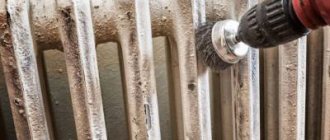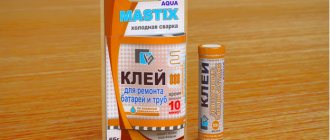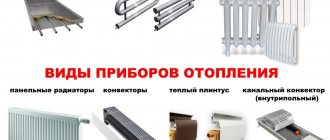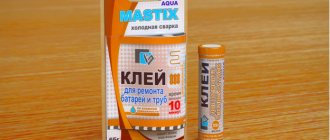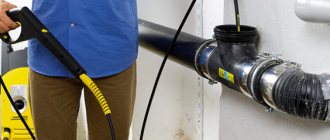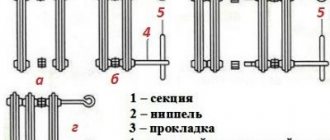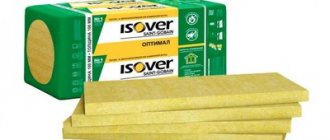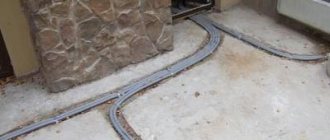Answer
What to do if you notice rust on a reliable old cast-iron battery that has been tested for years?
Is it worth changing it or is there a chance that the battery will still serve? And if this is a new cast iron battery, what should you do in this case?
Let's figure out what causes rust on a cast iron radiator.
So, one of the main qualities of cast iron is its corrosion resistance. During operation of the radiator, its surface becomes covered with so-called dry rust and corrosion practically does not proceed further. For this reason, cast iron radiators are very durable - it takes a lot of time for the thick wall of the radiator (which is exactly what a quality product should have) to rot through.
Has rust appeared on a cast iron battery?
This means the battery is simply damaged. It could be a small crack that is leaking a little. Or a shell formed during casting. In this place, the battery wall turned out to be thinner, and, accordingly, it succumbed to corrosion more quickly.
Of course, a small leak in the battery can be repaired by cold welding. By the way, there are “masters” who advise doing exactly this. They even sell special anti-rust paint for batteries. But if you simply cover up and paint over the rust, the consequences of such a “repair” can be very sad. After all, if in the middle of the heating season the battery breaks, it will not seem like much to either you or your neighbors. Not to mention the fact that you will be left in the cold without heating.
Therefore, if you notice rust on the battery or on the connection of sections, then there is only one way out - replacing the radiator.
Focus on quality
And to avoid the excruciating pain of wasted money, choose high-quality radiators from well-known manufacturers. For example, cast iron radiator Аdarad Оttoman 475 or radiator Аdarad Nostalgia 800/180. After all, a stingy person, as you know, pays twice: the first time when he buys cheap Chinese radiators, and the second time when, after a year or two, he replaces them with new ones, having previously flooded his neighbors.
In addition to all the advantages inherent in cast iron radiators, these batteries also have an excellent appearance. These radiators are guaranteed to last you at least 50 years. No rust and no leaks.
Washing with soda ash and whey
According to videos filmed by various experts, cleaning with soda ash is carried out as follows:
- Plugs (plugs) are placed on the two holes of the outer section.
- Soda ash is diluted in hot water. Half a standard pack for 6-10 liters is enough.
- They lift the heating radiator from the floor, placing it on the section with plugs. The section with two free holes should be at the top.
- Water with soda ash is poured through one hole. Air will escape through the other. Therefore, it does not need to be drowned out.
- Plug both holes and place the battery on the floor. The heating device must lie down.
- So that the soda ash can eat away any adhering dirt, rust, and possibly even old paint that has come in with the water, the radiator needs to be shaken. To do this, grab the top and raise/lower it several times. The bottom should not come off the floor. The same is repeated on the other side.
- Relax for 1 hour, watching a video on the Internet about the features of removing old paint from cast iron and applying new paint.
- Lightly tap along the entire perimeter with a wooden hammer. This is done so that the dirt is completely removed from the walls. At this time, the paint may come off. This means that it was poorly attached to the cast iron.
- Place the radiator on the nightstand so that one of the plugs is in the air.
- Place a bucket under the plug and unscrew the plug.
- After draining the water, the radiator should be flushed. To do this, unscrew the plug at the opposite end and insert the hose from the water supply. Open the tap. Water will flow into the radiator under pressure, thanks to which it will be possible to wash away dirt and completely clean the heating device.
To clean the radiator with serum, you need to follow all the steps described above. Just use whey instead of soda. This process, of course, can be seen in various videos.
The battery is leaking - what to do?
Almost every house and apartment has cast iron radiators, thanks to which it is always warm and cozy in cold weather. The service life is several decades, this is so long that almost everyone takes their work for granted, without thinking at all about the fact that they need to care for the battery.
Of course, when an incident occurs in the form of a leak, everyone begins to cut off the telephone numbers of the housing office and private repairmen. If this happened on a weekend, everything is somewhat more complicated. The average apartment resident has no idea what or how to do if a cast iron battery starts to leak.
Please note that if employees of the management company or heating network, during a scheduled inspection, will be able to identify and fix the breakdown in time, but this must be done on time and in advance.
A breakdown causes a lot of trouble if it happens in winter and there is already water in the system . Below we will tell you how to provide first aid to a battery and not leave your family without warmth and comfort, without flooding your neighbors.
Bandage based on plaster and cement
The service life of cast iron heating radiators is so long that residents take their work for granted, so if a leak or fistula appears in the wall of the device, they do not know what to do. It is especially unpleasant if the breakdown occurred in the midst of cold weather, but even in the off-season you cannot leave heating elements unattended.
The formation of a film on the inner surface of heating radiators can occur both during operation (deposition of sparingly soluble salts) and during their manufacture. Many well-established manufacturers, when manufacturing the radiator housing, treat it with protective agents.
Sooner or later, almost everyone faces the problem of corrosion of radiators (heating batteries). When you remove old radiators, you can’t help but feel horrified. Their interior is clogged with corrosion products and various types of deposits, and the walls of the batteries themselves have become incredibly thin and thin. All this happens due to the occurrence of corrosion processes. This method, unlike methods based on soda and salt, will help to cope even with old corrosion stains. It is especially effective for cleaning the inner surface of cast iron pots and frying pans.
What does the battery consist of?
If we are talking about old-type radiators, then in appearance they resemble accordions, while modern models are flat, due to which they heat up more evenly. Cast iron is a very strong material, but even it is not eternal, it has a limit of stability.
So the service life varies from 20 to 30 years, depending on operating conditions. If maintenance is carried out in a timely manner, the service life increases several times and the battery will last almost a hundred years.
Unfortunately, problems often arise in the places where the sections are fastened to each other; they wobble due to water or crack due to age. This is where the leak begins, which is best localized as soon as possible.
Placing a basin or saucepan under a dripping radiator is not a solution, as the crack tends to grow, so that one day a flood may occur! If we are talking about the winter period, then there is generally boiling water in the pipes, which poses a serious danger to the life and health of people.
How to remove rust from a radiator | Auto Bryansk
Nothing lasts forever, and over time everything falls into disrepair. If you have high humidity in your apartment, then the heating radiator can “give” you not only a bad look and peeling paint, but also rust on it as a bonus.
As a way out, of course, you can change the battery and buy a new one, but this is expensive and where is the guarantee that the new one will not become just as rusty in a couple of months?
It’s better not to buy a new (and expensive) radiator, but to remove the rust and paint it yourself, and it will look as good as new again.
Remove rust from radiator
There are several ways to remove rust from the metal surface of a radiator.
(Of course, the method is very long and difficult, but the most effective). You can also use the sandblasting method.
But, sometimes there are cases when the mechanical method cannot be used when we use mechanical compounds:
Home remedies (using what you have on hand):
What breaks most often
Although cast iron is a great conductor of heat, batteries have wide channels which minimize the risk of the battery clogging. In this case, it will heat the room worse. So why might the battery burst?
The radiator is too heavy , if the brackets are installed weakly or not deep enough (and it also happens that they are completely forgotten about and the battery hangs on the pipe), over time it sags under its own weight and tilts.
It would seem that this is not the case, but the slightest deviation is fraught with a decrease in the efficiency of the device. If no one paid attention to this and did not correct it, corrosion appears and leaks begin. Initially, corrosion damage appears as a small brown spot that gets larger.
Many people mistakenly believe that older radiators last much longer and work better, but there are also those who prefer newer models. Both will work properly if they are located no higher than the 6th floor.
Provided the water flow is stable and there are no water hammers, in this case the battery will heat and operate at least on the 10th or 20th floor. Otherwise, a leak may form at the joints . Any hardware store has a lot of sealants that will help correct the situation or prevent it altogether.
The first signs of trouble
There are a number of factors that indicate that something is wrong with the heating circuit or batteries. These include:
- Feeling of coolness in the room. In this case, it is worth asking your neighbors how warm it is in their apartment. If everything is in order, then you can start looking for problems in yourself. The reason may be simple contamination of the channels, misalignment of the device, or the presence of fistulas. In the first case, it is enough to wash the batteries, in the second, fasten or change the brackets and check the correct installation with a building level, and in the third, provide assistance to the “sick” radiator.
- If an incomprehensible coating appears on the battery, visible to the naked eye, then the reason for this is worn out gaskets. You will have to turn off the system, remove the batteries and install new ones, for example, from paronite.
- The leak is immediately noticeable. If it is small, then you can get by with a clamp or cold welding, otherwise you will have to completely change the device.
DIY repair
The inside of the cast iron is rough; if the radiator is foreign-made, then there are no roughnesses. Due to roughness, debris clings to the walls and settles inside.
If the battery is not cleaned, it will clog and simply burst from the high pressure of water.
If there is a leak at the joint, then a simple bandage and epoxy glue will help to cope with this, coat the joint with glue and soak the bandage with it, then wrap the joint tightly, wait until the glue sets and once again, sparing no glue, coat everything, then you can touch up the place no repairs were visible.
This is a temporary measure; after the heating season ends, it is worth replacing the section.
If a crack has formed , then a bandage and glue will not save the situation; you will need a clamp. It is better to use cold welding, a sealant that is very similar to window putty. Knead it thoroughly and cover the crack with it, after a few minutes everything will set and you can sleep peacefully for another heating season.
All other methods, unfortunately, are useless. Even after such independent repairs, after the end of the heating season, it is worth turning to a specialist for help.
Even the best cold welding is not a guarantee that the leak will not return after some time. Carry out technical inspections and minor repairs in a timely manner and let the radiator serve you faithfully.
Central heating allows you not to worry about the need to light the stove on time, as well as the fact that it is impossible to leave your home for a long time. But it also has its drawbacks. The main one is the invoice that comes every month. Another disadvantage is breakdowns that occur from time to time. This applies to both central highways and points within the house. When a problem occurs in the house, it is important to know what to do if the heating battery is leaking. The causes of the leak and how to eliminate it will be discussed in the article.
Where is the leak
The entire system consists of heat-transfer devices and wiring, which is represented by pipes. There is also a central riser through which hot water is supplied to the home. Any of the modules can leak. The cause of the leak may be poor-quality assembly, as well as defective material from which the pipes or radiators are made. Knowing this, you can predict where a leak might appear. Among such places are:
- the junction of the outlet pipe with the riser;
- pipe seam;
- leakage between battery sections;
- leak at the pipe inlet to the radiator;
- the appearance of a fistula in the radiator section.
Each type of leak requires its own approach to elimination. In some cases, the same materials may be used.
First actions
Since the reasons why leaks occur, as well as the locations of leaks, are different, there is no one universal rule that would quickly solve the difficulties that have arisen and eliminate the leak. But there is a certain procedure that can be followed when a leak is detected:
- leak localization;
- blocking the water flow;
- maintenance or replacement of the problem area.
Knot near the riser
A leak at the branch point from the riser may occur due to a leaky connection. If it is welded, then the cause of the leak may be a corrosive effect, which intensifies when using the heating system, like zero when unwinding the meter. Another reason for such a leak is the negligence of the craftsman who performed the joint. Also, the problem of leakage may be due to low-quality material that was purchased to save money. Often, a leak appears when the pipes are under high stress, which occurs due to welding work or loads on them with heavy objects.
The simplest way to eliminate a leak in such a place is a metal clamp and a piece of rubber. If such a leak is not uncommon, then you can stock up on a sufficient number of rubber seals in advance to eliminate the leak. They can be cut from an old bicycle inner tube. The sizes can be very different, because you never know where you will have to use this method. The first step is to try to temporarily eliminate the leakage using improvised means. Next, two clamps are loosened and put on the pipe. The cut piece of rubber is placed at the leak site and clamps are placed on it. It is worth clamping them with a screwdriver until the leak stops.
If it becomes clear that in a certain place the pipe wall has become thinner than necessary due to corrosion, then you can use a plaster or cement clamp rather than a rubber clamp to eliminate the leak. This method is also suitable when the leak is due to a crack in the pipe. A small amount of cement and gypsum must be added to warm water. The substances are mixed until a homogeneous mass is formed, but it must have good fluidity. You will need a thick bandage. It must be well soaked in the prepared solution. It is advisable to cut it into pieces of 20 cm. The soaked bandage is wrapped around the damage where there is a leak; this must be done in several layers so that the leak completely disappears.
In some cases, the problem occurs due to a leak directly on the thread. There is no point in delaying the decision to eliminate the leak. It is advisable to take a radical method and cut off the burst part, weld the pipe and cut a new thread. But while waiting for the repair team, you can apply a tourniquet to the leak site. It is done according to the principle of the previous one, but before soaking it in the cement mixture, you need to moisten the bandage with water and sprinkle it with salt.
Sequence of work
Depending on how serious the breakdown is, the steps to fix it depend. So, if the leak is small, then you can do without disconnecting the battery from the circuit, and for repairs you will need:
- Place a container under the breakdown site in case of a breakthrough or an oilcloth with rags to collect water.
- The area of the rupture or crack must be cleaned down to the base using a cable or sandpaper. It is necessary not only to remove a layer of paint, but to expose the metal itself.
- Degrease the prepared area with some solvent.
- If special glue or epoxy resin is used to repair the damage, then strips of thick fabric or bandages will be required. Apply the product to them and wrap several layers around the tear site.
- If cold welding is used, fabric is not needed.
- A clamp is put on and screwed onto the area captured by the sealant, but it is important to ensure that its clamps are on the opposite side of the leak. For example, a crack has formed on the inside of the radiator, which means the clamps will be on the outside, and vice versa.
- If the breakdown is serious and hot water is gushing out of the battery, then you need to call an emergency team, and not try to stop the leak yourself without the necessary tools.
Even the highest quality repairs do not guarantee long service life of the device. Restored cast iron radiators will still have to be replaced, and the sooner this is done, the safer it will be in the apartment.
Radiator sections
Although old cast iron radiators are the best option for central heating, they are often the cause of leaks. One of them may be water leakage in the place where the fins connect to each other. It is not always clear where the hole appeared due to pressure. Often water completely covers the battery. To identify the area where there is a leak, you need to completely turn off the water with the taps and wait until the pressure drops through the hole or release it with the Mayevsky tap. When the water stops flowing, you need to wipe the batteries dry and try to determine where the leak occurred. If the cast iron battery has leaked at the junction of the sections, then using cold welding would be an excellent solution.
Usually this substance is two-component and is sold in small tubes. At its core, cold welding is an epoxy resin with metal powder additives. Before using it, it is necessary to clean and degrease the area where the leak is noticed. It is important to remove not only rust, but also paint from the leak site; it is better to make small indentations on each side so that the interaction area is large. The leak area can be cleaned using a knife sharpening stone. Cold welding usually indicates the method of its use, but some types are not suitable for use with water, because when exposed to it, polymerization is impossible.
Fighting cracks of different diameters
Removing rust from a radiator There are several ways to remove rust from the metal surface of a radiator. The simplest is mechanical, that is, we take a battery, take metal brushes and sandpaper and clean off all the rust and the layer of previous paint. (Of course, the method is very long and difficult, but the most effective). You can also use the sandblasting method.
You can qualitatively eliminate a leak in an operating heating radiator on your own. This is an excellent option for those situations when there is no time to wait for representatives of the housing and communal services organization, and a welding machine is also unavailable. Many deformations occur due to poor-quality welds and corrosion damage.
Folk recipes also deserve attention, as they are simple and based on easily accessible and inexpensive ingredients.
The simplest is mechanical, that is, we take a battery, take metal brushes and sandpaper and clean off all the rust and the layer of previous paint.
Battery input
One of the problem areas where leaks often occur is the junction of the battery with the pipe from the riser. Typically, the appearance of such a leak is not caused by damage to the area, but by a leaky seal on the thread. To eliminate such a leak in the heating battery, it is necessary to close the riser as quickly as possible. After this, the pressure in the battery is reduced using a Mayevsky tap or another method. Using an adjustable wrench, unscrew the nut or coupling that makes the connection. Next, the rust at the leak site is cleaned, and the old sealant in the form of flax fiber is removed.
In case of such leak repair work, it is advisable to acquire a new nut or coupling. If they have been used for a long time and have not been changed, then they can easily burst while eliminating the leak. When the threads on a pipe are damaged, you can use a die to fix them. Several turns of tow are wound around the joint and it is covered with Unipak paste. After these steps, the assembly is reassembled and the supply tap is gradually opened. This will allow you to timely determine whether the leak has been completely eliminated.
Fistula in the rib of the battery
This type of leak can be considered one of the most unpleasant, since it requires significant effort to eliminate. But temporarily, you can use a simple method to eliminate such a leak. If the hole where the leak came from is small, then you will need to enlarge it a little. For these purposes, the water is completely shut off and the pressure in the batteries is reduced. After this, using a small drill, the hole is slightly drilled out. This is done in order to insert a peg into the hole from which water is leaking. It can be cut from a small wooden block. It will swell with water and plug the leak well.
Scheduled Maintenance
All of the above methods are mostly used in winter, when something urgently needs to be done. During the warm period of the year, you can carry out scheduled maintenance of risers and batteries so that leaks do not occur in winter. The battery is completely removed from its place and unrolled into sections. All threaded connections are cleaned of old sealant. If necessary, nipples are replaced with new ones. Intersectional gaskets are also completely replaceable. The detected fistulas are welded or sealed, and the battery is installed in its place. In the video below you can see other ways to eliminate leaks.
